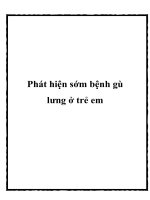PHÁT BAN ở TRẺ EM
Bạn đang xem bản rút gọn của tài liệu. Xem và tải ngay bản đầy đủ của tài liệu tại đây (891.8 KB, 20 trang )
CÁC BỆNH PHÁT BAN
THƯỜNG GẶP Ở TRẺ EM
GVC: Trần Thị Hồng Vân
Mục tiêu
• Định nghĩa phát ban
• Phân biệt các hình thái phát ban, kiểu phát
ban
• Triệu chứng LS, CLS, Chẩn đốn bệnh Sởi,
Rubella, Bệnh Tay, chân miệng, Thủy đậu
• Điều trị và phòng bệnh các bệnh trên.
1. Định nghĩa
- Phát ban là tình trạng bệnh lý do nhiều căn
nguyên gây nên với biểu hiện đỏ hoặc/và viêm
da và niêm mạc do giãn và ứ máu ở mao mạch
ngoại biên. Các dạng ban đỏ thường gặp là:
Nốt, mảng, vịng hoặc đa hình thái
-Sốt phát ban: Là tình trạng phát ban có biểu
hiện sốt kèm theo, thường do các căn nguyên
nhiễm trùng
Các thuật ngữ
•
•
•
Phát ban: Rash, skin eruption (sự phát ban ở da)
Ban cánh bướm: Butterfly rash
Diaper Rash
Drug Rash
Heat Rash (prickly heat)
Ban đỏ:
Erythema
Dạng nốt sẩn: Papule
Dạng chấm: Macule
Dạng nốt: Nodule
Ban vòng: Erythema Marginatum
Dạng mụn nước, bọng nước: Vesicle or Bullae
2. Căn nguyên
2.1. Phát ban do nguyên nhân nhiễm trùng:
• Bệnh do virus: EV(36 loại), sởi, thủy đậu, CMV, EBV…
• Bệnh do vi khuẩn: tụ cầu, liên cầu, Rickettsia…
• Bệnh do ký sinh trùng, nấm
2.2. Phát ban do nguyên nhân khơng nhiễm trùng:
• Dị ứng: với thuốc, tiếp xúc…
• Ban nhiệt
• Nhiễm độc : chì…
• Bệnh tự miễn: SLE…
2.3. Bệnh ngoài da: chàm, trứng cá…
Acne vulgaris: P
Actinic prurigo: P
Acute graft(ghép)-versus-host
reaction: M, Pa, P
Acute sunburn reaction: Pa
Arthropod bite: P
Atopic dermatitis: Pa, P, Pl
Chemotherapy-associated acral
erythema: M, Pa
Contact dermatitis: M, Pa, P, Pl
Dermatomyositis: M, Pa, P, Pl
Eosinophilic pustular folliculitis: P
Granuloma annulare: M, P, Pl
Hemangiomatosis, disseminated: P
Drug reaction: M, Pa, P, Pl
Juvenile rheumatoid arthritis: M, Pa, P
Kawasaki syndrome: M, Pa, PL
ivedo reticularis: M, Pa
Miliaria rubra: P
Nevus flammeus: M, Pa
Panniculitis, cold: Pl
Papular urticaria: P
Phototoxic or photoallergic dermatitis:
M, Pa, P, Pl
Pityriasis lichenoides: P
Pityriasis rosea: P, Pl
Pityriasis rubra pilaris: M, Pa, P, Pl
Polymorphous light reaction: P, Pl
Psoriasis: Pa, P, Pl
Subcutaneous fat necrosis: Pl
Systemic lupus erythematosus: M, Pa,
P, Pl
Telangiectasias: M
[M, macule(chấm); P, papule(sần); Pa,
patch(loang lổ); Pl, plaque(mảng).]
3. Tiếp cận chẩn đốn
3.1. Thăm khám LS tồn diện:
• Hình thái ban:
• Cách thức phát ban: khởi đầu, vị trí và thứ tự xuất
hiện ban, thời gian mọc, thời gian ban bay, tái diễn…
• Tính chất sốt
• Các triệu chứng kèm theo
• Yếu tố dịch tễ
3.2. Xét nghiệm:
Hives (urticaria)
mày đay
Hives occur as a rash or welts and are often itchy, or may burn or sting. They can appear anywhere on the body and may last minutes or days. Hives can
signal serious problems, especially if accompanied by difficult breathing or facial swelling. Medications like aspirin or penicillin; foods like eggs, nuts, and
shellfish; food additives; temperature extremes, and infections like strep throat can cause hives. Removing the trigger often resolves the hives and an
antihistamine can help. If hives persist or are accompanied with other symptoms, seek medical help.
Atopic dermatitis
A chronic problem causing dry skin, intense itching, and a raised rash, some children outgrow atopic dermatitis, or have milder
cases as they age. What causes atopic dermatitis isn't clear, but those affected may have a personal history of allergies and
asthma and a sensitive immune system.
Heat rash ('prickly heat')
The result of blocked sweat ducts, heat rash looks like small red or pink pimples. Appearing over an infant's head, neck, and shoulders, the
rash is often caused when well-meaning parents dress baby too warmly, but it can happen to any infant in very hot weather. A baby should be
dressed with only one more layer than an adult; though their feet and hands may feel cool to the touch, this is usually not a problem.
Ban XH hoại tử
Hand-foot-mouth disease (coxsackie)
This common, contagious childhood illness starts with a fever, then painful mouth sores and a non-itchy rash with blisters on hands, feet, and
sometimes buttocks and legs follow. It spreads through coughing, sneezing, and used diapers, so wash hands often when dealing with
coxsackie. Home treatment includes ibuprofen or acetaminophen (do not give aspirin) and lots of fluids. Not serious, coxsackie usually goes
away on its own in about a week.
Thủy đậu
Fifth disease ('Slapped Cheek')
Fifth disease is a mild rash illness caused by parvovirus B19 that passes in a couple weeks, fifth disease starts with flu-like symptoms,
followed by a face and body rash. Spread by coughing and sneezing, it's most contagious the week before the rash appears. Treatment
includes rest, fluids, and pain relievers (do not use aspirin if your child has fever), but watch for signs of more serious illness. I
Ringworm
Worms don't cause ringworm. Instead, this skin infection is caused by a fungus living off dead skin, hair, and nail tissue. Starting
as a red, scaly patch or bump, it develops into an itchy red ring with raised, blistery, or scaly borders. Ringworm is passed on by
skin-to-skin contact with a person or animal, and by sharing items like towels or sports gear. Most ringworm infections can be
treated with antifungal creams.
BIỂU HIỆN LS
CHẨN ĐOÁN PHÂN BIỆT
BỆNH DO VK
BỆNH DO VR
SỐT KHƠNG FC, HIb, não mơ cầu
ĐẶC HIỆU
Cúm, HV6,7
BAN
LCK nhóm A, tụ cầu, não mô cầu
HSV, adenoviruses,
varicella-zoster virus,
Epstein-Barr virus, measles
virus, rubella virus, human
herpesviruses 6 and 7
BỆNH HH,
VIÊM KM
Streptococcus pneumoniae,
Haemophilus influenzae
(nontypable and type b),
Neisseria meningitidis
Mycoplasma pneumoniae,
Chlamydia pneumoniae
Adenoviruses, influenza
viruses, respiratory
syncytial virus,
parainfluenza viruses,
rhinovirus
VIÊM CƠ
TIM, MNT
Staphylococcus aureus,
Haemophilus influenzae type b,
Mycoplasma
Adenoviruses, influenza
virus, parvovirus
Chẩn đốn phân biệt SPB
Bệnh
Tg ủ
bệnh
Sởi
Rubella
Tồn phát
Tr.ch khác
8-11 ngày Viêm long
Mắt đỏ
Koplik
Phát ban kiểu sởi
Viêm thanh
quản
Viêm não
12-14
ngày
Khơng có
Ban sần, đỏ sậm tím,
lan nhanh
Hạch to (sau
tai, gáy)
3 ngày
Sốt
Khơng mệt
Ban sần, hồng, cách
xa nhau, thoáng qua,
hết nhanh
Hay co giật
trong cơn sốt
đầu tiên
Đào ban 10-14
ngày
TE
(Roseola
infantum)
HHV-6
Khởi phát
Chẩn đốn phân biệt SPB
Bệnh
Tg ủ bệnh
Khởi phát
Tồn phát
Hồng ban NK 7-14 ngày
Không
Vết đỏ ở má,
ban như vết
cắt ở chi, 7-14
ngày
Sốt tinh hồng 2-5 ngày
nhiệt
(Scarlet
fever)
group A
Streptococcus
1-2 ngày, nôn, Ban chấm đỏ,
đau họng
đau, tụ từng
đám, đỏ da
toàn thân,
7ngày ban
bay, bong da
Ban chấm
đậm ở nếp
gấp da, họng
đỏ, a. hạnh
nhân to, đỏ,
lưỡi sưng đỏ
Nhiễm VR
đường ruột
Thay đổi
Gây dịch
Viêm dạ dày
ruột
Thay đổi
Ban,
Mụn nước
Chấm XH
Tr.ch khác
4. Điều trị:
•
•
•
•
•
Theo từng bệnh
ĐT căn nguyên
Điều trị triệu chứng
Chăm sóc, dinh dưỡng, vệ sinh da-niêm mạc
Tránh : bơi thuốc ngồi da khơng đúng chỉ
định; kiêng khơng vệ sinh da
5. Một số bệnh phát ban thường gặp









